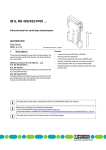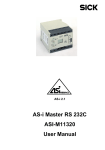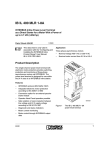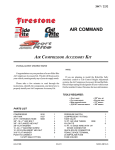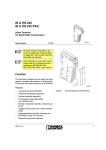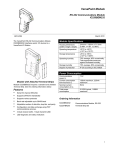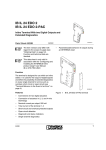Download IB IL RS 232-PRO (-PAC) - Configurators
Transcript
IB IL RS 232-PRO (-PAC) Inline terminal for serial data transmission; firmware version 1.20 or later 2 x AUTOMATION Data sheet 7112_en_03 1 © PHOENIX CONTACT - 10/2008 Function description The terminal is designed for use within an Inline station. It is used to operate standard I/O devices with serial interfaces on a bus system. Difference between IB IL RS 232 and IB IL RS 232-PRO IB IL RS 232 Parameterization and data exchange are carried out via the bus using PCP services. Features – – – – – – – – A serial I/O channel (V.24 (RS-232)) DTR/CTS handshake supported Various protocols supported Transmission speed can be set up to 38400 baud Number of data bits, stop bits, and parity can be set 4 kbyte receive buffer and 1 kbyte transmit buffer Parameterization and data exchange via the bus using process data Diagnostic and status indicators IB IL RS 232-PRO Parameterization and data exchange are carried out via the bus using process data. This makes faster communication times possible with smaller amounts of data than with the IB IL RS 232. This data sheet is only valid in association with the IL SYS INST UM E user manual. Make sure you always use the latest documentation. It can be downloaded at www.download.phoenixcontact.com. This data sheet is valid for the products listed on the following page: IB IL RS 232-PRO (-PAC) 2 Ordering data Products Description Type Order No. Pcs./Pkt. Inline terminal for serial data transmission, including connectors and labeling fields IB IL RS 232-PRO-PAC 2878722 1 Inline terminal for serial data transmission IB IL RS 232-PRO 2878515 1 The listed connector set is needed for the complete fitting of the IB IL RS 232-PRO terminal. Accessories Description Type Order No. Pcs./Pkt. Connector set with a standard connector and a shield connector IB IL AO/CNT-PLSET 2732664 1 Documentation Description Type Order No. Pcs./Pkt. "Automation terminals of the Inline product range" user manual IL SYS INST UM E 2698737 1 "INTERBUS addressing" data sheet DB GB IBS SYS ADDRESS 9000990 1 3 Technical data General data Housing dimensions (width x height x depth) 24.4 mm x 136 mm x 72 mm (with connectors) Weight 90 g (without connectors), 135 g (with connectors) Operating mode Process data mode with 6 words Transmission speed 500 kbps Permissible temperature (operation) -25°C to +55 °C Permissible temperature (storage/transport) -25°C to +85 °C Permissible humidity (operation/storage/transport) 10% to 95% according to DIN EN 61131-2 Permissible air pressure (operation/storage/transport) 70 kPa to 106 kPa (up to 3000 m above sea level) Degree of protection IP20 Class of protection Class 3 according to EN 61131-2, IEC 61131-2 Connection data for Inline connectors Connection method Spring-cage terminals Conductor cross-section 0.08 mm2 to 1.5 mm2 (solid or stranded), 28 - 16 AWG Interfaces Bus Local bus Through data routing Serial interfaces Type V.24 (RS-232) interface with DTR/CTS handshake Data terminal equipment (DTE) Electrical data according to EIA (RS) 232, CCITT V.28, DIN 66259 Part 1 Input impedance 5 kΩ typical Permissible input voltage range -30 V to +30 V Switching thresholds 0.8 V to 2.4 V Hysteresis 0.5 V typical Output voltage "HIGH" (with 3 kΩ load) 6.7 V typical Output voltage "LOW" (with 3 kΩ load) -6.7 V typical Output voltage "HIGH" (no-load operation) ≤25 V Output voltage "LOW" (no-load operation) ≥ -25 V 7112_en_03 PHOENIX CONTACT 2 IB IL RS 232-PRO (-PAC) Interfaces (continued) Permissible load capacity 2500 pF Short-circuit protected against GND Yes Short-circuit current ±60 mA, maximum Power consumption Communications power UL 7.5 V Current consumption at UL 155 mA, typical, 225 mA, maximum* Total power consumption 1.163 W, typical; 1.688 W, maximum (approximately)* * All connections of the serial interface are short-circuited. This terminal takes no current from the UM and US potential jumpers. Supply of the module electronics by the bus terminal module Connection method Potential routing Power dissipation Power dissipation in the module PEL = 1.163 W Power dissipation of the housing PHOU 1.2 W, maximum (within the permissible operating temperature) Limitation of simultaneity, derating No limitation of simultaneity, no derating Protective equipment None Electrical isolation/isolation of the voltage areas Electrical isolation of the logic level from the serial interface is ensured by the DC/DC converter. Common potentials The serial interface control and data lines have galvanically the same potential. FE is a separate potential area. Separate potentials in the system consisting of bus terminal/power terminal and I/O terminal Test distance Test voltage 5 V supply incoming remote bus/7.5 V supply (bus logic) 500 V AC, 50 Hz, 1 min 5 V supply outgoing remote bus/7.5 V supply (bus logic) 500 V AC, 50 Hz, 1 min V.24 (RS-232) interface/7.5 V supply (bus logic) 500 V AC, 50 Hz, 1 min V.24 (RS-232) interface/24 V supply (I/O) 500 V AC, 50 Hz, 1 min V.24 (RS-232) interface/functional earth ground 500 V AC, 50 Hz, 1 min 7.5 V supply (bus logic) / 24 V supply (I/O) 500 V AC, 50 Hz, 1 min 7.5 V supply (bus logic) / functional earth ground 500 V AC, 50 Hz, 1 min 24 V supply (I/O) / functional earth ground 500 V AC, 50 Hz, 1 min Error messages to the higher-level control or computer system None Approvals For the latest approvals, please visit www.download.phoenixcontact.com or www.eshop.phoenixcontact.com. 7112_en_03 PHOENIX CONTACT 3 IB IL RS 232-PRO (-PAC) 4 Diagnostic/status indicators and terminal point assignment D R x D T x D R S 2 3 2 1 2 1 .1 1 1 2 .1 1 .2 2 2 2 .2 1 .3 3 3 2 .3 1 .4 4 4 2 .4 4.3 Terminal point assignment Connector Terminal Signal Assignment point 1 1.4, 2.4 FE Functional earth ground All other terminal points of this connector are not used. 2 1.1 RxD Serial data input 2.1 TxD Serial data output 1.2 +5 V Control output, internally wired to +5 V DC 2.2 CTS Control input for hardware handshake 1.3 DTR Control output for hardware handshake 2.3 GND GND for serial interface 1.4, 2.4 Shield Shield connection Observe the connection notes on page 9. 7 1 1 2 A 0 0 3 Figure 1 4.1 IB IL RS 232-PRO-PAC Local diagnostic and status indicators Des. Color D Green Serial interface: RxD Yellow TxD 4.2 Yellow Meaning Diagnostics Terminal is receiving data from the connected device Terminal is transmitting data to the connected device Function identification Orange 7112_en_03 PHOENIX CONTACT 4 IB IL RS 232-PRO (-PAC) 5 Internal circuit diagram L o c a l b u s U U U O P C D L + A n a L - 7 ,5 V R x D 5 V T x D 5 V 5 V 1 µ P R S -2 3 2 In te rfa c e / R S -2 3 2 In te rfa c e / R x D + 2 4 V (U S ) T x D + 5 V C T S + 2 4 V (U M ) 1 D T R 7 1 1 2 A 0 0 4 Figure 2 Internal wiring of the terminal points Key: Protocol chip (bus logic including voltage conditioning) OPC Diagnostic and status indicators with function information µ P R S -2 3 2 In te rfa c e DC/DC converter with electrical isolation X X X RS-232 Interface / Optocoupler x x x Microprocessor 1 Capacitor Ground, electrically isolated from ground of the communications power UL Other symbols used are explained in the IL SYS INST UM E user manual. 7112_en_03 PHOENIX CONTACT 5 IB IL RS 232-PRO (-PAC) 6 V.24 (RS-232) interface The connector set consists of a shield connector and a standard connector. The V.24 (RS-232) interface on the terminal represents a piece of DTE (data terminal equipment). This means that connector 2 terminal point 2.1 (TxD) is always used to transmit and connector 2 terminal point 1.1 (RxD) is always used to receive. Handshake signals: Signal CTS (Clear To Send) The exception is: 3964R, XON/XOFF Protocol The standard requires that DCE (data communication equipment) be connected to the V.24 interface as a peer. However, DTE can also be connected. Please refer to the connection notes under 6.2 and 6.3. Measuring the voltage between the connection points for the TxD and GND signals in idle state will determine whether the device to be connected to the V.24 (RS-232) interface is a form of DTE or DCE. If the voltage measures approximately -5 V, the device is a form of DTE. If the voltage is approximately 0 V, the device is a form of DCE. Example: When using a 25-pos. standard connector (see Figure 3 on page 7) the voltage between pin 2 (TxD) and pin 7 (GND) must be measured. 6.1 V.24 module handshake signals Any device with a V.24 (RS-232) interface can be connected to the V.24 (RS-232) interface on the terminal. Both the terminal and the device connected to the V.24 (RS232) interface can act as a transmitter and a receiver for data exchange. As errors can occur during data exchange if both devices transmit or receive simultaneously, the handshake is used as a procedure for the mutual signaling of clear to receive and clear to transmit. The terminal supports DTR and CTS handshake signals. Each uses one wire of the connecting cable. Meaning Direction The terminal receives the CTS Input signal from the connected device via the V.24 (RS-232) interface. If the CTS signal is set to High, the terminal can transmit data. You can disable the CTS signal evaluation (see "Transmission without hardware handshake on page 17). DTR (Data Terminal Ready) The DTR signal is transmitted from Output the IB IL RS 232-PRO terminal, i.e., set to High, once it is ready to receive. The peer connected to the V.24 (RS-232) interface is now able to transmit. After 4,095 characters (4 kbytes), the terminal receive buffer is full and the DTR signal is set to Low. As soon as more characters are read from the bus side, the DTR signal is set to High and the terminal is ready to receive. With the transparent and XON/XOFF protocols, DTR is set to "0" if fewer than 15 characters are free in the receive FIFO. The connecting signals are described from the point of view of the terminal, i.e., from the point of view of the DTE. 7112_en_03 PHOENIX CONTACT 6 IB IL RS 232-PRO (-PAC) 6.2 V.24 interface wiring with four-wire handshake The TxD, RxD, DTR, and CTS signals are used for a fourwire handshake connection between the terminal and the device to be connected. Each signal corresponds to one wire in the connecting cable. An Inline male connector is required on the terminal side. A 9-pin or 25-pin socket is required on the opposite side depending on the device to be connected. Both GND pins are also wired. In Figure 3 and Figure 4 the shield connector is connected on the right-hand side of the terminal. In this case, a capacitor is placed between the shield and FE. If the shield is to be placed directly on FE, the shield connector must be connected on the left-hand side of the terminal. Observe the connection notes on page 9. In Figure 3 and Figure 4, it is assumed that the signal assignment of the connectors for the device to be connected corresponds to the assignment of a PC connector. In individual cases, however, the signal assignment of the pins might be different, as the DTE-DTE connections as well as the connections between 25-pin and 9-pin connectors and sockets are not standardized. 1 2 1 1.1 2 1 1.2 2 2 2.2 1.3 3 3 2.3 1.4 4 4 2.4 IB IL RS 232-PRO (-PAC) DTE device (e.g., PC) 2.1 2 TxD RxD 1.1 3 RxD +5 V 1.2 4 RTS CTS 2.2 5 CTS TxD DTR 1.3 20 DTR GND 2.3 7 Inline connector (Connector 2) Figure 3 1 GND 14 1 25 13 Junction D-SUB socket 25-pos 7112B008 V.24 (RS-232) interface wiring with handshake for DTE (25-pin) 2 1 1.1 2 2.1 1 1 1.2 2 2 2.2 1.3 3 3 2.3 1.4 4 4 IB IL RS 232-PRO (-PAC) 2.4 DTE device (e.g, PC) TxD 2.1 3 TxD RxD 1.1 2 RxD +5 V 1.2 7 RTS 2.2 8 CTS DTR 1.3 4 DTR 5 GND CTS GND 2.3 Inline connector (Connector 2) Figure 4 7112_en_03 2.1 1 6 1 9 5 Junction D-SUB socket 9-pos 7112B012 V.24 (RS-232) interface wiring with handshake for DTE (9-pin) PHOENIX CONTACT 7 IB IL RS 232-PRO (-PAC) 6.3 V.24 (RS-232) interface wiring without handshake 1 2 For wiring without handshake, the transmission can only be executed with the help of both TxD and RxD signals. In the same way as the GND contacts. Both wires for the TxD and RxD signals are connected to the IB IL RS 232-PRO terminal male connector and are soldered to the socket on the side of the device to be connected. In addition, a jumper is connected on the male connector between the terminal points for the +5 V and CTS signals and on the socket between the pins for the RTS and CTS signals. In this way, permanent readiness to receive of the peer is simulated and the connected device is again able to transmit data via the V.24 interface. In Figure 5 and Figure 6 the shield connector is connected on the right-hand side of the terminal. In this case, a capacitor is placed between the shield and FE. If the shield is to be placed directly on FE, the shield connector must be connected on the lefthand side of the terminal. Observe the connection notes on page 9. In Figure 5 and Figure 6, it is assumed that the signal assignment of the connectors for the device to be connected corresponds to the assignment of a PC connector. In individual cases, however, the signal assignment of the pins might be different, as the DTE-DTE connections as well as the connections between 25-pin and 9-pin connectors and sockets are not standardized. The terminal sets the DTR signal to Low before the receive FIFO overflows. As the DTR signal is not evaluated for wiring without handshake, some of the data sent to the module via the V.24 interface may be lost until the module is ready to receive again. 1 1.1 2.1 1 1 1.2 2 2 2.2 1.3 3 3 2.3 1.4 4 4 2.4 IB IL RS 232-PRO (-PAC) DTE device (e.g., PC) TxD 2.1 2 TxD RxD 1.1 3 RxD +5 V 1.2 4 RTS CTS 2.2 5 CTS DTR 1.3 20 DTR GND 2.3 7 GND Inline connector (Connector 2) Figure 5 1 14 1 25 13 Junction D-SUB socket 25-pos 7112B009 V.24 interface wiring without handshake for DTE (25-pos.) 2 1 1.1 2 2.1 1 1 1.2 2 2 2.2 1.3 3 3 2.3 1.4 4 4 IB IL RS 232-PRO (-PAC) 2.4 DTE device (e.g., PC) TxD 2.1 3 TxD RxD 1.1 2 RxD +5 V 1.2 7 RTS CTS 2.2 8 CTS DTR 1.3 4 DTR GND 2.3 5 GND Inline connector (Connector 2) Figure 6 7112_en_03 2 6 1 9 5 Junction D-SUB socket 9-pos 7112B013 V.24 interface wiring without handshake for DTE (9-pos.) PHOENIX CONTACT 8 IB IL RS 232-PRO (-PAC) 7 Connection notes 7.1 1 By assigning terminal points 1.4 and 2.4 of both connectors you can connect the cable shield either using a capacitor (connector 2) or directly (connector 1) to functional earth ground (FE). If you connect the shield via connector 1, you must connect the shield connector on the lefthand side of the terminal. All wires must be connected to connector 2. Ensure that on connector 2, terminal point 1.2 (+5 V) is exclusively used to provide the 5 V signal for the CTS input (terminal point 2.2), in the event of communication without handshake. In this case insert a jumper between the terminal points. 2 D D RxD TxD RS D Rx D Tx 232 RS 232 1 2 1 2 1 11 1 2 22 2 3 33 3 4 44 4 DTR CTS TxD RxD With the two connection options, you can connect one side of the cable shield directly and one side using a capacitor to FE without any additional effort. In this way, you can prevent ground loops occurring if a shield with two direct connections were placed on FE. Shield capacitively connected to FE Figure 7 7112B005 Connection of an I/O device with a serial interface Any other use is not permitted. Use a connector with shield connection when installing the I/O device. Figure 7 and Figure 8 show the connection schematically (without shield connector). In this example, the V.24 interface wiring for communication with 4-wire handshake is shown. 7.2 Shield connected directly to FE 1 2 D D RxD TxD RS D Rx D Tx 232 RS 232 1 2 1 2 11 1 2 22 2 3 33 3 4 44 4 TxD RxD 1 Figure 8 7112B006 Connection of an I/O device with a serial interface In this example, the V.24 interface wiring for communication without handshake is shown. You should insert a jumper between connection points 1.2 (+5 V) and 2.2 (CTS). 7112_en_03 PHOENIX CONTACT 9 IB IL RS 232-PRO (-PAC) 8 Data storage and transmission The terminal stores the received serial data in an intermediate buffer until it is requested from the serial interface by the bus controller board or the device. Serial data traffic can be managed using various protocols. The protocol used depends on the type of protocol supported by the peers. 8.1 Overview of supported protocols Protocol Receive buffer Transpa- 4096 bytes rent End-to3 buffers end with 330 bytes each Dual 2 buffers buffer with 330 bytes each 3964R 3 buffers with 330 bytes each XON/ XOFF 8.2 4096 bytes Transmit Special features memory when receiving 1023 bytes 1023 bytes (including end characters) 1023 bytes (including end characters) 3 buffers with 330 bytes each Two end characters are filtered out Only stores the most recently received data, end characters are filtered out Data exchange with software handshake, time monitoring, and checksum 1023 bytes Software handshake Transparent protocol If the transparent protocol is used, serial data is transmitted through the terminal in the same format it was received from the serial interface or the bus side. The transmit FIFO (First-In-First-Out memory) can store 1023 bytes (1 kbyte) and the receive FIFO can store 4096 bytes (4 kbytes). If the terminal receives another character after the 4095th character, the error pattern is stored in the receive FIFO. All further characters are ignored. 7112_en_03 8.3 End-to-end protocol The serial data is conditioned for the end-to-end protocol. If serial data is sent from the bus side, two additional characters, the first and second delimiters, are attached for transmission to the serial interface. The first and second delimiters are defined upon terminal configuration. Serial data sent from the serial interface can only be read by the user if the terminal has received the first and second delimiters. The two delimiters confirm that the serial data has been received without error and the maximum data length of 330 bytes has been observed. The delimiters are filtered out when the data is read by the bus side. Unlike in the transparent protocol, the receive memory is not organized as a FIFO but as a buffer. 3 buffers with 330 bytes each are available. If the buffer size of 330 bytes is exceeded, without the two delimiters being detected, the buffer is overwritten again. The transmit FIFO consists of 1023 bytes. The delimiters are attached to, and stored with, the data to be sent. 8.4 Dual buffer protocol With this protocol, the last received data block is stored. A data block is defined as a sequence of characters with the first and second delimiter, as in the end-to-end protocol. As soon as a new data block is received, the previous one is overwritten. This is achieved by means of two buffers, which are written alternately. In this way, there is always one buffer ready to receive serial data while the second buffer stores the most recently received data block. A data block is only regarded as complete once both delimiters have been detected, one after the other. It can then be read from the bus side. If the buffer size of 330 bytes is exceeded, without the two delimiters being detected, the buffer is overwritten again. When transmitting serial data, the same is valid as for the end-to-end protocol: If serial data is sent from the bus side, two additional characters, the first and second delimiters, are attached for transmission to the serial interface. PHOENIX CONTACT 10 IB IL RS 232-PRO (-PAC) 8.5 3964R protocol This protocol, developed by Siemens, is the most complex. It uses beginning and end identifiers, checksum and a time monitoring function. 3 buffers are available for transmitting, 3 buffers are available for receiving. Character delay time: Acknowledgment delay time: Block waiting time: Number of attempts to establish a connection: 220 ms 2s 10 s 6 The optional 3964 priority defines which device may send first (high priority) if there is an initialization conflict (several devices attempting to send data simultaneously). 8.6 XON/XOFF protocol This protocol operates like the transparent protocol, however, using a software handshake. 9 Programming data/ configuration data 9.1 Local bus (INTERBUS) ID code Length code Process data channel Input address area Output address area Parameter channel (PCP) Register length (bus) 9.2 BFhex (191dec) 06hex 96 bits 12 bytes 12 bytes 0 bytes 12 bytes Other bus systems For the programming/configuration data of other bus systems, please refer to the corresponding electronic device data sheet (e.g., GSD, EDS). Data transmission with this protocol is controlled by the XON and XOFF characters. XON is set to 11hex and XOFF to 13hex. If the terminal receives an XOFF, no more serial data will be sent until an XON is received. The terminal itself will transmit an XOFF if the available space in the receive memory is less than 15 bytes. As soon as more memory becomes available again, the module will transmit a single XON. Serial data is not filtered when it is transmitted. So any characters occurring with the code defined for XON and XOFF are transmitted and may trigger undesirable events at the receiver. When serial data is received, the XON and XOFF characters are filtered and are not available as data. Any characters with the XON or XOFF code are lost. Ensure that characters with these codes do not appear in the data stream. 7112_en_03 PHOENIX CONTACT 11 IB IL RS 232-PRO (-PAC) 10 Err: error x = 0 or 1; the assignment depends on the command. Process data The terminal process image comprises six data words each in input and output direction. Bit 15 = error: Is not valid for the Read Characters command. For the meaning of bit 15 for this command, please refer to Section "Read Characters command" on page 16. For the assignment of the illustrated (word.bit) or (byte.bit) view to your INTERBUS control or computer system, please refer to the DB GB IBS SYS ADDRESS data sheet. Code (Bin) The terminal has six process data words. Word Byte in the Motorola format Byte in the Intel format 0 0 1 2 2 3 4 3 5 6 4 7 8 5 9 10 11 Data Data Data Data Data Data Data Data Data 001 010 011 Data Data Data 8 11 10 Data 9 Data 6 Data 7 Data 4 Data 5 Data 2 Data 3 Data 0 Data 1 Data 000 Status Command/ parameter parameter OUT IN 1 100 101 110 111 The byte representation in the Motorola format, also called Big Endian (high order byte at starting address) corresponds to the INTERBUS standard representation. All byte representations in the data sheet have this format. The byte representation in the Intel format is also called Little Endian (low order byte at starting address). The command is used to determine the function. The actually transmitted data depends on the command. 10.1 Word 0 general Control word 15 14 13 12 11 10 9 8 7 6 0 Command OUT x x parameter 5 4 x x 3 2 1 x x x 0 x 5 4 x x 3 2 1 x x x 0 x Code Command (hex) (With bit 15 = 0) 0 Read status bits. Input word 1 contains the number of characters received. 1 Transmit characters 2 Store characters temporarily 3 Read characters OUT parameter = Chex: Read FW version, OUT parameter = Dhex: Read configuration 4 Write configuration 5 Toggle command 1: Transmit characters 6 Toggle command 2: Store characters temporarily 7 Toggle command 3: Read characters Command toggling Command toggling is used to execute a command on a terminal again. In this way a second command code is available for the same function. This applies for the following commands: – Transmit characters – Store characters temporarily – Read characters Here, bit 14 is used for toggling. If, for example, you wish to transmit character strings in sequence, use the command code 001hex for the first transmission and then use 101hex and 001hex alternately. Status word 15 14 13 12 11 10 9 8 7 6 Err Command IN parameter x x 7112_en_03 PHOENIX CONTACT 12 IB IL RS 232-PRO (-PAC) 10.2 Read Status Bits command Format of the process data word 0 Control word 15 14 0 13 0 12 0 11 10 9 8 7 DTR 6 5 DTR (if DTR control enabled) 4 3 2 1 Transmit Receive error error Receive error Code Meaning Code Meaning 0hex DTR = Logic 0 0hex No action 1hex DTR = Logic 1 1hex Reset receive error The DTR signal can only be controlled when DTR control is enabled via process data, that is when the DTR control bit has been enabled in the configuration (see "Write Configuration command" on page 17). 0 Transmit error Code Meaning 0hex No action 1hex Reset transmit error Status word 15 14 0 13 0 12 0 11 10 9 8 7 6 Amount of CTS Receive received data buffer not empty 5 Transmit buffer full 4 3 2 Receive Res. Transmit buffer full error CTS (if configured) 1 Receive error Receive buffer full Code Meaning Code Meaning 0hex CTS = Logic 0 0hex Not full 1hex CTS = Logic 1 1hex Full The CTS bit is only updated when the "Mapping the CTS signal" bit was set in the configuration (see "Write Configuration command" on page 17). 0 Receive buffer not empty Transmit error Code Meaning 0hex No error 1hex Error Send buffer not empty Code Meaning 0hex Empty 1hex Not empty Receive error Code Meaning 0hex No error 1hex Error Send buffer full Code Meaning 0hex Not full 1hex Full 7112_en_03 Receive buffer not empty Code Meaning 0hex Empty 1hex Not empty PHOENIX CONTACT 13 IB IL RS 232-PRO (-PAC) Bit/status Bit 0 = '1' Bit 1 = '1' Bit 2 = '1' Bit 3 = '1' Bit 4 = '1' Bit 5 = '1' Effect The receive buffer is not empty, there are characters to be read. The receive error indicates that a 3964R telegram could not be received without error after six transmit attempts by the serial peer or after the block waiting time had elapsed. The transmit error indicates that a 3964R telegram could not be transmitted from the module to the serial peer without error after six transmit attempts. The telegram was rejected. Reserved The receive buffer is full: Transparent and XON/XOFF protocol: Residual capacity: < 15 characters 3964R and end-to-end protocol: Residual capacity: none The transmit buffer is full: 3964R protocol: Bit 6 = '1' Bit 7 = '1' Bits 8 to 11 Protocol All 3964R 3964R Transparent, end-to-end, 3964R, XON/XOFF All Residual capacity: none Dual buffer, transparent, end-to-end, and XON/XOFF protocol: Residual capacity: ≤ 30 characters The transmit buffer is not empty, characters to be transmitted are available. The CTS status is mapped here when the "Mapping the CTS signal" bit was set in the configuration. Number of characters received. If the code = Fhex, more than 14 characters have been received. All All Both error bits (bits 1 and 2) are not automatically reset. They can only be reset by the process data output word. In the transparent and XON/XOFF protocols, the input word 1 contains the total number of characters received. With the Read Status Bits command the content of the input data is continuously updated. Unlike with other commands toggling is not required. 7112_en_03 PHOENIX CONTACT 14 IB IL RS 232-PRO (-PAC) 10.3 Transmit Characters command Process data is stored in the transmit memory and then directly transmitted via V.24 (RS-232). A maximum of eleven characters can be transmitted. The OUT parameter determines the number of characters to be transmitted. Characters stored in the intermediate buffer are transmitted first. After the command has been executed successfully the intermediate buffer is cleared. Process data assignment for the Transmit Characters command with 17 characters (C1 - C17) Word Byte OUT IN OUT IN 0 0 1Bhex 1Bhex 56hex 56hex 1 1 C1 – C12 – 2 C2 – C13 – 2 3 C3 – C14 – 4 C4 – C15 – For protocols with end identifiers the end identifier is added after every transmitted block (11 characters, maximum) 10.4 3 5 C5 – C16 – 6 C6 – C17 – 4 7 C7 – – – 8 C8 – – – 5 9 C9 – – – 10 C10 – – – 11 C11 – – – Reasons for an error bit set: – OUT parameter = 0 and intermediate buffer empty – OUT parameter >11 – Not enough space in the transmit memory – Not enough space in the intermediate buffer Store Characters Temporarily command The transmit data is stored in an intermediate buffer, which can store 330 characters. No characters are transmitted. The OUT parameter determines the number of characters. The Transmit Characters command is used for transmitting the data stored temporarily. In this way character blocks of up to 330 characters can be transmitted. They are divided over 20 telegrams with 11 characters each. Process data assignment for the Save Characters command and subsequent Transmit Characters command with 41 characters (C1 - C41). Word Byte OUT IN OUT IN OUT IN OUT IN 0 0 2Bhex 2Bhex 6Bhex 6Bhex 2Bhex 2Bhex 18hex 18hex 1 1 C1 – C12 – C23 – C34 – 2 C2 – C13 – C24 – C35 – 2 3 C3 – C14 – C25 – C36 – 4 C4 – C15 – C26 – C37 – For protocols with end identifiers the end identifier is added after every transmitted block (41 characters) 7112_en_03 3 5 C5 – C16 – C27 – C38 – 6 C6 – C17 – C28 – C39 – 4 7 C7 – C18 – C29 – C40 – 8 C8 – C19 – C30 – C41 – 5 9 C9 – C20 – C31 – – – 10 C10 – C21 – C32 – – – 11 C11 – C22 – C33 – – – Reasons for an error bit set: – OUT parameter = 0 or >11 – Not enough space in the intermediate buffer PHOENIX CONTACT 15 IB IL RS 232-PRO (-PAC) 10.5 Read Characters command This command is used to read a maximum of eleven characters. The IN parameter contains the number of valid characters available in the input data. Process data assignment for the Read Characters command with eleven characters (C1 - C11) Word Byte OUT IN 0 0 30hex 3Bhex 1 1 – C1 2 – C2 2 3 – C3 4 – C4 3 5 – C5 For the end-to-end, dual buffers and 3964R protocols, bit 15 in the status word is not used as error bit but indicates whether there are still other characters from the received block that remain to be read. 6 – C6 4 7 – C7 8 – C8 5 9 – C9 10 – C10 11 – C11 Bit 15 in the status word Bit/ status Bit 15 = '0' For the indicated protocols, a data transfer is handled as block that is identified by a special end identification. When reading the characters received, it is important to know whether the characters provided with this command all belong to one single block or whether there are still characters that remain to be read. The status bit "Receive buffer is not empty" does not provide this information as it also indicates whether additional blocks have been received. For this reason, bit 15 is used in this case. A maximum block length of 330 characters is supported. Effect Protocol The characters read are the last ones in the received End-to-end, block. dual buffer, There are still some more 3964R characters to be read from the received block. Bit 15 = '1' Together with the toggle bit, the upper nibble of the status word might have the values Bhex (1011bin) and Fhex (1111bin). Example: In the 3964R protocol a block with 20 characters was received. For reading, the Read Characters command must be given twice. The second time the command is given, the toggle bit is set. Process data assignment for the Transmit Characters command with 20 characters (C1 - C20) Word Byte OUT IN OUT IN 7112_en_03 0 0 30hex BBhex 70hex 79hex 1 1 – C1 – C12 2 – C2 – C13 2 3 – C3 – C14 4 – C4 – C15 3 5 – C5 – C16 6 – C6 – C17 4 7 – C7 – C18 8 – C8 – C19 5 9 – C9 – C20 10 – C10 – – 11 – C11 – – PHOENIX CONTACT 16 IB IL RS 232-PRO (-PAC) 10.6 Write Configuration command Process data assignment for the Write Configuration command 5 6 7 40hex Error pattern Protocol Baud rate data width 2 3 4 – – – – – – – 10 9 Protocol 8 8 5 9 10 – – – 11 Reserved 4 Reserved 3 40hex 1 Reserved 2 Direct baud rate 1 OUT 0 2nd delimiter 0 1st delimiter Word Byte IN Output words 0 to 5 – Output word 1 for the Write Configuration command 15 14 13 12 Transmission DTR control Mapping the w/o HW CTS signal handshake 11 7 6 5 Baud rate 4 3 2 1 Data width 0 Element value range The options in bold are default settings. DTR control Code Transmission without hardware handshake Code 0hex Meaning Transmission dependent on CTS signal Transmission dependent on CTS signal CTS = 0: Transmission disabled, CTS = 1: Transmission enabled 7112_en_03 Transmission independent of CTS signal Representation in CMD/PC WORX 0hex Automatic Automatic 1hex Via process data Via process data Code Meaning Representation in CMD/PC WORX Exception: 3964R, XON/XOFF Protocol 1hex Meaning CTS signal mapping 0hex CTS signal is not mapped to input process data 1hex CTS signal is mapped to input process data Representation in CMD/PC WORX CTS signal is not mapped to input process data CTS signal is mapped to input process data Transmission independent of CTS signal PHOENIX CONTACT 17 IB IL RS 232-PRO (-PAC) Protocol Baud rate Code Meaning Code Value 00hex Transparent 00hex 110 baud 01hex End-to-end 01hex 300 baud 02hex Dual buffer 02hex 600 baud 03hex 3964R with low priority 03hex 1200 baud 04hex 3964R with high priority 04hex 1800 baud 05hex XON/XOFF 05hex 2400 baud 06hex 4800 baud 07hex 9600 baud 08hex 19200 baud 09hex 38400 baud 0Dhex Directly, basis 500 kbaud 0Ehex Directly, basis 62.5 kbaud 0Fhex Directly, basis 15625 baud The specified baud rates of 110 baud to 38400 baud are adequate for most applications. However, you can freely choose the baud rate by direct programming. For this, use the 0Dhex, 0E hex, and 0Fhex baud rate codes in output word 1. See "Direct Baud Rate (DBC)" on page 20. Data width Code Meaning Representation in CMD/PC WORX Data bits Parity Stop bits 00hex 7 Even 1 7 data bits, even parity, 1 stop bit 01hex 7 Odd 1 7 data bits, odd parity, 1 stop bit 02hex 8 Even 1 8 data bits, even parity, 1 stop bit 03hex 8 Odd 1 8 data bits, odd parity, 1 stop bit 04hex 8 None 1 8 data bits, without parity, 1 stop bit 05hex 7 None 1 7 data bits, without parity, 1 stop bit 06hex 7 Even 2 7 data bits, even parity, 2 stop bits 07hex 7 Odd 2 7 data bits, odd parity, 2 stop bits 08hex 8 Even 2 8 data bits, even parity, 2 stop bits 09hex 8 Odd 2 8 data bits, odd parity, 2 stop bits 0Ahex 8 None 2 8 data bits, without parity, 2 stop bits 0Bhex 7 None 2 7 data bits, without parity, 2 stop bits 7112_en_03 PHOENIX CONTACT 18 IB IL RS 232-PRO (-PAC) Error pattern Code Meaning 24hex $ xxhex Any character First delimiter Code Meaning 0Dhex Carriage Return (CR) xxhex Any character Second delimiter Code Meaning 0Ahex Line Feed (LF) xxhex Any character 7112_en_03 The error pattern contains the character that is written into the FIFO, if a character was received with an error (not valid for the 3964R protocol). Reasons are e.g. parity errors, exceeded value range, noise interference. In the transparent and XON/XOFF protocols, the pattern is also used if the receive FIFO is full and further characters are received. The first delimiter and the second delimiter contain the end characters for the dual buffer and the end-to-end protocols. After successful configuration the characters for the receive and transmit FIFO are reset. In this way, all transmit and receive data that have not yet been processed will be deleted. Reasons for an error bit set: – Using a reserved code – Setting a reserved bit PHOENIX CONTACT 19 IB IL RS 232-PRO (-PAC) Default: Transparent protocol Baud rate: 19200 baud Word Byte 0 1 2 3 4 Direct baud rate Reserved 7 2nd delimiter 6 1st delimiter 5 Baud rate data width 4 Protocol 3 Error pattern 2 40hex 1 Meaning 0 Data width: 8 data bits with odd parity and one stop bit Configuration (in hex): 4000 0083 0000 0000 OUT IN 40 40 00 – 00 – 83 – 00 – 00 – 00 – – – 8 5 9 10 – – – – Reserved – – – – – – 11 Reserved Example – – Direct Baud Rate (DBC) Direct programming of the baud rate is selected in the output word 1 using the 0Dhex, 0Ehex and Fhex baud rate codes. You can select a basic clock for the baud rate. The actual baud rate is calculated according to the following formula: Baud rate = basic clock / (DBC + 1) Specify DBC in the output byte 6. To determine DBC change the equation to read: DBC = basic clock / baud rate - 1 Example: The baud rate is 15625 baud. A basic baud rate of 500 kbaud (code 0Dhex) is chosen. Determine the direct baud rate: DBC = (500000 baud / 15625 baud) - 1 = 31dec= 1Fhex Here is an example for the first 4 output words: 40 00 00 D2 00 00 1F hex. Programming of the direct baud rate theoretically enables a maximum value of 500 kbaud. Proper operation of the terminal is tested and guaranteed for up to 38400 baud. Operation with higher baud rates depends on the application. 7112_en_03 PHOENIX CONTACT 20 IB IL RS 232-PRO (-PAC) 10.7 Read Configuration command Process data assignment for the Read Configuration command 10 11 x x x 00 00 x 00 x 9 00 5 8 00 x 2nd delimiter 4 7 x x 6 Direct baud rate 5 1st delimiter 3 4 x Error pattern 2 3 Baud rate data width 2 x 3Dhex 3Dhex OUT IN 10.8 1 1 x 0 0 Protocol Word Byte Read Firmware Version command With a control word 3C00hex the second input word supplies the firmware version and the type code. 15 14 13 12 11 10 9 8 Firmware version, e.g.,100hex 7 6 5 4 3 2 1 Type code: 8hex 0 Type code 8hex is identical to the type code of the IB IL RS 232 (-PAC). 7112_en_03 PHOENIX CONTACT GmbH & Co. KG • 32823 Blomberg • Germany • Phone: +49-(0) 5235-3-00 PHOENIX CONTACT • P.O.Box 4100 • Harrisburg • PA 17111-0100 • USA • Phone: +717-944-1300 www.phoenixcontact.com 21





















